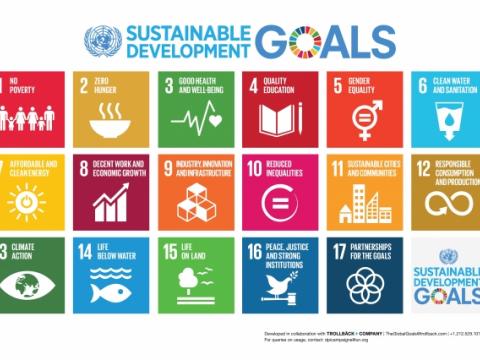Everything you wanted to know about the Sustainable Development Goals (but were afraid to ask!)

This month world’s leaders will gather in New York to formally adopt the successor to the Millennium Development Goals: called the Sustainable Development Goals. But what are these goals and what do they mean for the world’s poorest people? What do they mean for me?
What are the Sustainable Development Goals?
The Sustainable Development Goals (SDGs) are a set of goals and targets designed to end extreme poverty over the next 15 years. The goals are universal so are expected to guide the policies and practices of all countries. They replace the Millennium Development Goals (MDGs) which end this year.
There are 17 Sustainable Development goals including:
- End poverty in all its forms, everywhere
- End hunger, achieve food security and improved nutrition and sustainable agriculture
- Ensure access to water and sanitation for all
- Promote just, peaceful and inclusive societies
You can find a full list of the goals and targets here.
Were the Millennium Development Goals effective?
The MDGs saw the international community commit to poverty reduction on a level we’d never seen before. As a result, the number of people living in extreme poverty (less than US$1.25 per day) has more than halved to 836 million. The number of preventable child deaths also fell dramatically, from 12.7 million in 1990, to six million today.
World Vision was an active contributor to the goals. As part of its efforts to reduce the number of maternal and new-born deaths, it trained and continues to support over 100,000 community health-workers, including midwives.
World Vision is also the largest non-government supplier of clean water in the developing world; reaching a new person with clean water every 30 seconds. This is particularly important when you consider that diarrhoea is the second biggest cause of death for children under five years old. Further, between 2010 and 2014, World Vision was able to protect 20 million people from malaria by distributing long-lasting insecticide treated mosquito nets.
Find out more about what the MDGs achieved here.
What lessons did we learn from the MDGs and why do we need new goals?
For all its success, the MDGs failed to serve the world’s most vulnerable children; those at risk of child labour, early marriage and other forms of violence. It also neglected people living in fragile or conflict-affected places such as Syria and Afghanistan.
Those responsible for drafting the new Sustainable Development Goals appear to have taken the critique on-board declaring in the SDGs document “we will endeavour to reach the furthest behind first.”
The United Nations’ Deputy Secretary General Jan Eliasson has also been quoted as saying “there can be no sustainable development without peace and no peace without sustainable development.”
What makes the SDGs different?
In addition to committing to reach the furthest behind this time, the goals and targets have taken into account feedback from ordinary citizens. World Vision and other agencies consulted with communities in developing countries to find out exactly what they thought would improve their lives. Further, the UN launched an online ‘My World’ survey asking people to prioritise the areas they’d like to see addressed in the goals.
How will the SDGs impact World Vision’s work in the future?
Through its global advocacy work, World Vision will help communities hold their governments accountable for progress. World Vision will also integrate the goals into its own development and emergency-response programming.
When will the SDGs take effect?
World leaders will meet at a special United Nations Summit in New York from 25-27 September to formally adopt the new goals. They will officially take effect in January 2016. The deadline for the goals is 2030.